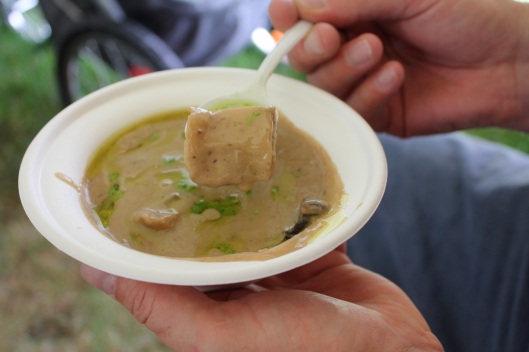Tags
Alberta mushrooms, Alberta Mycological Society, August event, Devonian Botanical Garden, fungi, mushroom tasting, mushrooms, mycology, wild mushrooms
Last Sunday (August 18th), B and I and the Little One took in the Alberta Mycological Society’s (AMS) annual “City of Champignons” Mushroom Exposition at the Devonian Botanical Garden. It was our first time attending this event and we were looking forward to seeing the displays, tasting some wild mushrooms and talking to local experts about our own recent forays in the backyard here at cabinorganic.
We were amazed at the amount to work that went into the fresh, wild mushroom displays. These were gathered and arranged by AMS volunteers, both the evening before and that very morning. They were arranged and labelled in family groups so it was very easy for us to find many of the mushrooms that we see daily on our twice daily walks but haven’t got around to identifying yet.

The displays were also a nice opportunity for mushroom lovers like ourselves to look closely at, handle, appreciate the diversity and smell the wonderful mushroom aromas. Experts were on hand at each table to answer any questions and provide additional information.
The AMS also had a few large displays featuring local mushrooms, medicinal mushrooms and poisonous mushrooms. There were also tables featuring recommended books, and field guides and posters were also available for purchase.
The entire afternoon was filled with events:
11 am: Mushroom walk in the garden
12 noon: Presentation on “A dozen common Alberta mushrooms”
1 pm: Fungi Flavors with Chef Chad Moss
2 pm: Mushroom walk in the garden
3 pm: Mushroom tastings with Chef Chad Moss

Our favorite part of the day was the tastings! Chef Chad Moss had prepared an amazing feast for the senses, including wild lobster, honey and oyster mushrooms, which were carefully paired with smoked bacon, brie and rose petal, sea bean and other unexpected flavors. These were served on a freshly baked baguette.
In his presentation on Fungi Flavors, Chad challenged us to let go of our dependance on recipes and be creative with our wild mushroom finds in our own kitchens. He really inspired me to let the mushroom be the central taste instead of my usual habit of masking it with garlic, onion or ginger. Instead, he demonstrated how more subtle flavor combinations, which may include apple cider, scotch, earl grey tea, cardamon, bacon, brie, nuts, even fresh strawberries and cream can bring out the unique earthy flavors of these meaty delights.
We were also treated to a wild mushroom soup, rich and full of chunks of assorted wild mushrooms and topped with a herb oil.
We are so grateful to the Devonian Botanical Garden for their spring, summer and fall mushroom classes, as well as to the Alberta Mycological Society for their many educational events and opportunities throughout the year. You don’t have to be a member to attend some of these events but your annual membership gets you invited to many smaller scale events, talks and forays all over Alberta. Here you can rub shoulders with, gather and cook wild mushrooms alongside people who are passionate about fungi and have been enjoying mushrooms for years. These events often involve a small feast where the mushrooms can be enjoyed together as a group.
For more information, please click on this link to visit the Devonian Botanical Garden’s website. Be sure and check out the Events link to see what other events are lined up at the garden before they close for the season. The fall mushroom course is coming up on September 7th. Click here to register.
Also, click on this link to visit the Alberta Mycological Society’s webpage for information on memberships, events and a wealth of information provided by the society as well as links to other helpful websites. If you’re keen to get in on the action, the Great Alberta Mushroom Foray will take place on August 30th in the Castle Mountain area, SW Alberta. See the website for details. Also, be sure and check out their current exhibit AMS@the Royal Albert Museum until September 15th, 2013.
Enjoy your forays and wild mushroom adventures!













